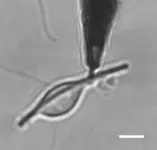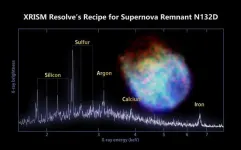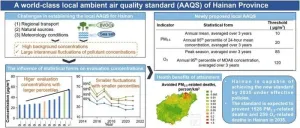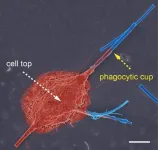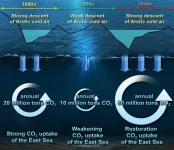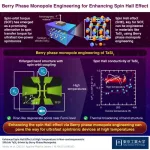(Press-News.org) WASHINGTON – U.S. Naval Research Laboratory (NRL) researchers, Kevin Cronin and Drew Rodgers, receive Technology Achievement Award for Lightweight Hydrogen Fuel Cells for Unmanned Aerial Systems (UAS) research efforts at Defense Manufacturing Conference held in Nashville, Tenn., Dec. 11, 2023.
The Department of Defense (DOD) has a critical need for increased power and endurance for persistent Intelligence, Surveillance and Reconnaissance (ISR) and transmission of radio frequency (RF) sources for communications and targeting.
“It is rewarding to be able to contribute to such an innovative and impactful project alongside a talented team of researchers,” said Cronin from the Chemistry Division’s Alternative Energy Section. “Working at the Naval Research Laboratory means pushing the frontier of science and technology to equip the warfighter with the most advanced capabilities we can deliver. This project evolved from basic and applied research to a mature system with a domestic manufacturer, ready for integration and adoption.”
Hydrogen fuel cells are also well suited for low signature applications because they provide energy through an electrochemical reaction, so there are fewer moving parts and a much lower operating temperature relative to combustion engines. The byproduct is water, which supports initiatives to reduce carbon emissions.
“I leveraged over a decade of fuel cell experience to develop many of the mechanical designs necessary for assembly, compression, and packaging of components,” said Rodgers from the Tactical Electronic Warfare Division’s (TEW) Vehicle Research Section. “The TEW Vehicle Research Section has a long history of partnering with the Chemistry Division to help develop, fabricate, integrate, and test advanced power and energy systems within our unmanned vehicles. This was certainly a group effort culminating in many years of hard work from multiple contributors and will provide the warfighter with improved capabilities now and into the future.”
Commercially available hydrogen fuel cells for UAS have inadequate performance for military use. There is presently no U.S. vendor that makes a lightweight fuel cell on the order of 1-3 kilowatts, leaving a key manufacturing technology gap that prevents RF surveillance by fuel cell powered UAVs.
This Office of the Secretary of Defense (OSD) Manufacturing Science and Technology Program (MSTP) established a mature fuel cell system to fill this gap, as well as a domestic fuel cell manufacturing base. Other spiral developments have emerged to allow joint implementation of this fuel cell technology in a variety of applications beyond UAS.
“By leveraging hydrogen as an energy source, Marines can keep their unmanned aerial systems flying longer and their generators running quieter,” Cronin said. “These advantages support persistent intelligence, surveillance, and reconnaissance and decreased signature for expeditionary advanced base operations.”
NRL’s fuel cell research is sponsored by the OSD MSTP, the Office of Naval Research (ONR), the Naval Air Warfare Center Aircraft Division (NAWCAD), and the Marine Corps Expeditionary Energy Office (USMC E20).
“The reason we were able to demonstrate why this manufacturable fuel cell was so important is from collaboration with NAWCAD, who both furthered the fuel cell maturation and led the integration into the Stalker UAS,” Cronin said. “Sponsorship from ONR was also critical, both for the early applied research preceding the MSTP project, as well for the original FY22 Hydrogen Small Unit Power (H-SUP) project. Finally, USMC E2O has since picked up the torch from ONR and is now funding the new and improved H-SUP into FY24 and beyond.”
The Marine Corps established the Expeditionary Energy Office to reduce energy consumption, with the goals of increasing combat effectiveness by reducing the need for liquid fossil fuel by 50 percent by 2025 and using liquid fuel only for mobility systems, which will be more energy efficient than systems are today.
“As the Navy’s corporate research laboratory, NRL conducts world-class basic, applied and developmental research in the chemical and physical sciences and innovates new concepts, materials, and capabilities to increase U.S. Naval power and enable superior advantage,” said Dr. John N. Russell, Jr., NRL Chemistry Division Superintendent. “The research, development and demonstration of Lightweight Hydrogen Fuel Cells for unmanned aerial systems was possible due to a strong culture of collaborative, multidisciplinary research at NRL that drew on a deep science and engineering foundation in the chemistry of alternative liquid fuels and unmanned systems.”
About the U.S. Naval Research Laboratory
NRL is a scientific and engineering command dedicated to research that drives innovative advances for the U.S. Navy and Marine Corps from the seafloor to space and in the information domain. NRL is located in Washington, D.C. with major field sites in Stennis Space Center, Mississippi; Key West, Florida; Monterey, California, and employs approximately 3,000 civilian scientists, engineers and support personnel.
For more information, contact NRL Corporate Communications at (202) 480-3746 or nrlpao@nrl.navy.mil
END
NRL researchers receive Defense Manufacturing Technology Achievement Award
2024-01-05
ELSE PRESS RELEASES FROM THIS DATE:
Applications open for School of Advanced Science on Technology and Innovation Strategies and Policies for Economic Development
2024-01-05
The São Paulo Advanced School on Technology & Innovation Strategies and Policies for Economic Development will be held from June 24 to July 05, 2024, at the University of Campinas (UNICAMP) in São Paulo state, Brazil.
Reporters are invited to register for the scientific sessions and short courses, which will present state-of-art science and results of new research.
The School provides an opportunity to learn about and debate recent developments in the economics of technological change and in science, technology and innovation (ST&I) policy studies. The programme comprises numerous seminars, intensive courses, and roundtable discussions focusing ...
Ancestors of primates lived in pairs
2024-01-05
A study carried out by CNRS1 scientists working with an international team has revealed that around 70 million years ago, when dinosaurs existed, the ancestors of primates most commonly lived in pairs. Only 15% of them opted for a solitary lifestyle. This discovery — that our ancestors adopted variable forms of social organization — challenges the hitherto commonly accepted hypothesis that at the time of dinosaurs, the ancestors of primates lived alone, and that pair living evolved much later. Most likely, pair living offered significant benefits, such as easier reproduction and reduced costs of thermoregulation by huddling in pairs.
While several studies have already been conducted ...
Mysterious missing component in the clouds of Venus revealed
2024-01-05
What are the clouds of Venus made of? Scientists know it’s mainly made of sulfuric acid droplets, with some water, chlorine, and iron. Their concentrations vary with height in the thick and hostile Venusian atmosphere. But until now they have been unable to identify the missing component that would explain the clouds’ patches and streaks, only visible in the UV range.
In a new study published in Science Advances, researchers from the University of Cambridge synthesised iron-bearing sulfate minerals that are stable under the harsh chemical conditions in the Venusian clouds. Spectroscopic analysis revealed that a combination of two minerals, rhomboclase and acid ferric ...
NASA/JAXA XRISM mission reveals its first look at X-ray cosmos
2024-01-05
The Japan-led XRISM (X-ray Imaging and Spectroscopy Mission) observatory has released a first look at the unprecedented data it will collect when science operations begin later this year.
The satellite’s science team released a snapshot of a cluster of hundreds of galaxies and a spectrum of stellar wreckage in a neighboring galaxy, which gives scientists a detailed look at its chemical makeup.
“XRISM will provide the international science community with a new glimpse of the hidden X-ray sky,” said Richard Kelley, the ...
Hainan's quest for pristine air: Charting a course to global air quality leadership by 2035
2024-01-05
Air pollution significantly impacts human health, with Hainan Province in China aiming to achieve world-leading ambient air quality by 2035, despite already having relatively good air quality in China. The existing Ambient Air Quality Standards (AAQS) offer insufficient guidance for further enhancing air quality in Hainan, which stands at the forefront of China's environmental protection efforts. Consequently, it is imperative to develop Hainan's local AAQS. This initiative, responding to WHO's strengthened guidelines, aims to address unique regional challenges in air quality ...
Asbestos: the size and shape of inhaled nanofibers could be exclusively responsible for the development of pulmonary fibrosis
2024-01-05
The pathogenic potential of inhaling the inert fibrous nanomaterials used in thermal insulation (such as asbestos or fibreglass) is actually connected not to their chemical composition, but instead to their geometrical characteristics and size. This was revealed by a study, published on 3 January 2024 in the journal Nature Nanotechnology, conducted on glass nanofibers by a French-Chinese team including a CNRS chemist.1
The reason for this is the inability of the macrophages2 naturally present in pulmonary alveolar tissue to eliminate foreign bodies that are too large. The study was initially conducted in vitro with electrochemical nanosensors, and revealed that when confronted ...
Monitoring the well-being of reservoir water through an uncrewed surface vehicle
2024-01-05
In a recent tragic incident, approximately 100 elephants in Africa perished due to inadequate access to water. The United Nations Environment Programme (UNEP) issues a warning that around 2.5 billion people worldwide could face water scarcity by 2025. In the face of water shortages affecting not only human society but also the entire ecological community due to the climate crisis, it becomes crucial to adopt comprehensive measures for managing water quality and quantity to avert such pressing challenges.
A research team led by Professor Jonghun Kam and PhD candidate Kwang-Hun Lee from the Division of Environmental Science and ...
Arctic cold snap transforms into a blessing
2024-01-05
The recent cold spell has plunged the nation into a deep freeze, resulting in the closure of 247 national parks, the cancellation of 14 domestic flights, and the scrapping of 107 cruise ship voyages. While the cold snap brought relief by significantly reducing the prevalence of particulate matter obscuring our surroundings, a recent study indicates that, besides diminishing particulate matter, it is significantly contributing to the heightened uptake of carbon dioxide by the East Sea.
According to research conducted by a team of researchers ...
Feathers from deceased birds help scientists understand new threat to avian populations
2024-01-05
As concerns over the world’s declining bird population mount, animal ecologists developed an analytical approach to better understand one of the latest threats to feathered creatures: the rise of wind and solar energy facilities.
“Bird mortality has become an unintended consequence of renewable energy development,” said Hannah Vander Zanden, an assistant professor of biology at the University of Florida. “If we want to minimize or even offset these fatalities, especially for vulnerable populations, we need to identify the geographic origin of affected birds. In other words, are the dead birds local or are they coming ...
Using berry phase monopole engineering for high-temperature spintronic devices
2024-01-05
Spintronic devices are electronic devices that utilize the spin of electrons (an intrinsic form of angular momentum possessed by the electron) to achieve high-speed processing and low-cost data storage. In this regard, spin-transfer torque is a key phenomenon that enables ultrafast and low-power spintronic devices. Recently, however, spin-orbit torque (SOT) has emerged as a promising alternative to spin-transfer torque.
Many studies have investigated the origin of SOT, showing that in non-magnetic materials, a phenomenon called the spin Hall effect (SHE) is key to achieving SOT. In these materials, the existence of a “Dirac band” ...

